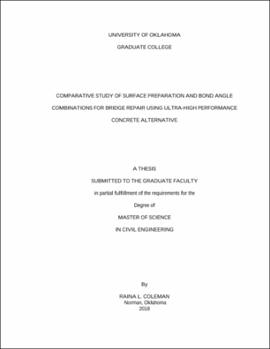| dc.description.abstract | Ultra-high performance concrete (UHPC) is a type of concrete with advanced mechanical properties compared to normal strength concrete and that can be used for connections and repairs in bridges. Most UHPC used in the field is proprietary and significantly more costly than normal strength concrete. The Oklahoma Department of Transportation (ODOT) desires a UHPC alternative made with local, non-proprietary materials. In this study, the application of a lab developed UHPC alternative developed by McDaniel (2017) was tested and analyzed. The nature of this study was comparative, so all methods and tests conducted were similar to a previous study performed by Funderburg (2018) with a proprietary UHPC product, the Lafarge product Ductal®. After reviewing relevant literature, some modification to the UHPC alternative, J3, was required due to the excessive amount of high range water reducer (HRWR) found on the surface of the concrete after mixing. Trial mixes of J3 were made to optimize the amount of HRWR needed in the concrete used for specimens. Next, large scale slab specimens were cast using two panels of ODOT Class AA mix and a UHPC joint connecting the two panels. These slab specimens were tested in flexure, statically and cyclically. Composite modulus of rupture specimens and slant shear specimens were also made and were composed of half normal strength concrete acting as the base concrete and half UHPC. The modulus of rupture specimens were cast at four different interface angles and with three different surface preparations. The modulus of rupture specimens were tested using three point loading and the slant shear specimens were tested in compression. The results of both the large scale and small scale specimens were compared to that of the previous study by Funderburg. This research study produced promising results in regards to the UHPC alternative. While the J3 mix could benefit from improved workability, all specimens still performed well in the testing stage. The sand blasting surface preparation and 45 degree interface angle performed the best but the wire brushed and 60 degree specimens were also comparable. The slab specimens exceeded the calculated failure load possibly due to the additional strength provided through the UHPC joint. The conclusions made from this study, based on the properties tested, indicate that UHPC mix J3 is a comparable alternative to Ductal® and would be useful for field applications. | en_US |
